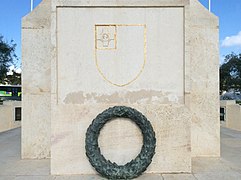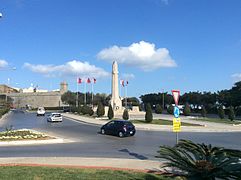
Floriana, also known by its title Borgo Vilhena, is a fortified town in the South Eastern Region area of Malta, just outside the capital city Valletta. It has a population of 2,205 as of March 2014. Floriana is the birthplace of many famous Maltese, amongst which the composer of the national anthem, 'L-Innu Malti', Robert Samut; former Bishop of Malta Dun Mauro Caruana, the poets Oliver Friggieri and Maria Grech Ganado, the writer and politician Herbert Ganado and Swedish Idol winner Kevin Borg.

The Macquarie Place Park, also known as the Macquarie Place Precinct, is a heritage-listed small triangular urban park located in the Sydney central business district in the City of Sydney local government area of New South Wales, Australia. The former town square and milestone and now memorial, public park and monument is situated on the corner of Bridge Street and Loftus Street. It is named in honour of Governor Lachlan Macquarie. The precinct includes The Obelisk or Macquarie Obelisk, the Sirius anchor and gun/cannon, the Statue of Thomas Sutcliffe Mort, the historic Underground Public Conveniences and the Christie Wright Memorial Fountain. The property was added to the New South Wales State Heritage Register on 5 March 2010.

An eternal flame is a flame, lamp or torch that burns for an indefinite time. Most eternal flames are ignited and tended intentionally, but some are natural phenomena caused by natural gas leaks, peat fires and coal seam fires, all of which can be initially ignited by lightning, piezoelectricity or human activity, some of which have burned for hundreds or thousands of years.
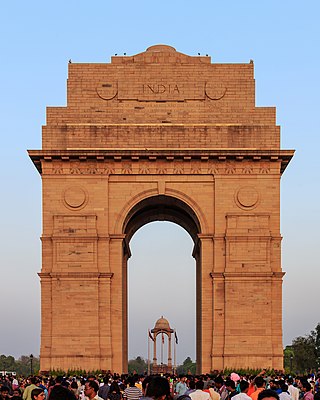
The India Gate is a war memorial located near the Kartavya path on the eastern edge of the "ceremonial axis" of New Delhi, formerly called duty path. It stands as a memorial to 84,000 soldiers of the British Indian Army who died between 1914 and 1921 in the First World War, in France, Flanders, Mesopotamia, Persia, East Africa, Gallipoli and elsewhere in the Near and the Far East, and the Third Anglo-Afghan War. 13,300 servicemen's names, including some soldiers and officers from the United Kingdom, are inscribed on the gate. Designed by Sir Edwin Lutyens, the gate evokes the architectural style of the memorial arch such as the Arch of Constantine, in Rome, and is often compared to the Arc de Triomphe in Paris, and the Gateway of India in Mumbai.

The National Monument is a 132 m (433 ft) obelisk in the centre of Merdeka Square, Central Jakarta, symbolizing the fight for Indonesia. It is the national monument of the Republic of Indonesia, built to commemorate the struggle for Indonesian independence.
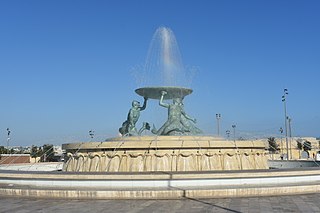
The Tritons’ Fountain is a fountain located just outside the City Gate of Valletta, Malta. It consists of three bronze Tritons holding up a large basin, balanced on a concentric base built out of concrete and clad in travertine slabs. The fountain is one of Malta's most important Modernist landmarks.

The Tomb of the Unknown Soldier is a war memorial dedicated to the Soviet soldiers killed during World War II. It was designed by architects D. I. Burdin, V. A. Klimov, Yu. R. Rabayev and sculptor Nikolai Tomsky.

Elizabeth II was Queen of Malta as head of state of Malta from 1964 to 1974. Malta was an independent sovereign state and a constitutional monarchy, sharing a monarch with other Commonwealth realms, including the United Kingdom. Elizabeth's constitutional roles in Malta were mostly delegated to a governor-general.
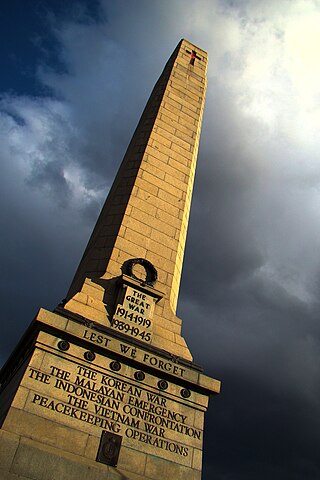
Hobart Cenotaph is the main commemorative military monument for the Australian state of Tasmania. It is located in the capital Hobart in a prominent position on the Queens Domain, on a small rise overlooking the city and River Derwent. The Cenotaph sits directly above what was once the location of the Queens Battery.

The Malta Memorial is a war memorial monument to the 2,298 Commonwealth aircrew who lost their lives in the various Second World War air battles and engagements around the Mediterranean, whilst serving with the Commonwealth Air Forces flying from bases in Austria, Italy, Sicily, islands of the Adriatic and Mediterranean, Malta, Tunisia, Algeria, Morocco, West Africa, Yugoslavia and Gibraltar, and who have no known grave.
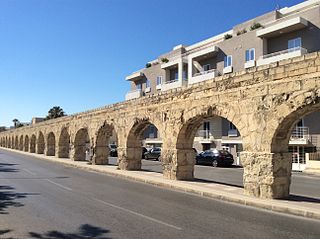
The Wignacourt Aqueduct is a 17th-century aqueduct in Malta, which was built by the Order of Saint John to carry water from springs in Dingli and Rabat to the newly built capital city Valletta. The aqueduct was carried through underground pipes and over arched viaducts across depressions in the ground.

Southport War Memorial is in London Square, Lord Street, Southport, Merseyside, England. It consists of an obelisk flanked by two colonnades in the form of Greek temples. Outside the colonnades are memorial gardens, each containing a Pool of Remembrance and fountains. The memorial was designed by the local architects Grayson and Barnish, and the carving was executed by Herbert Tyson Smith. It was unveiled in 1923 by the Earl of Derby. Following the Second World War and subsequent conflicts further inscriptions and names have been added. The memorial is recorded in the National Heritage List for England as a designated Grade II* listed building.

The North Borneo War Monument is a monument that was erected on 8 May 1923 by the North Borneo Chartered Company in Bond Street, Jesselton, British North Borneo. Originally, it was a memorial for the fallen British soldiers during the World War I but later extended to include the Australian soldiers in World War II. The monument stands today in the city park of Kota Kinabalu, the capital of the Malaysian state of Sabah.
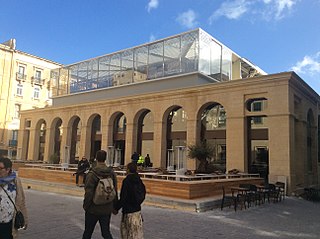
Is-Suq tal-Belt, also known as the Covered Market, is a 19th-century market hall located in Valletta, Malta. It is notable for being the first building in Malta to be constructed mostly of iron. The building was severely damaged in World War II, and the rebuilding was insensitive to the original structure. Further alterations were made in later decades, and the market began to decline in the 1970s. An attempt to rebrand it as a shopping arcade known as Ixtri Malti in the 1980s was unsuccessful. The market continued to decline until it was renovated in 2016–17, and reopened as a food market in January 2018.
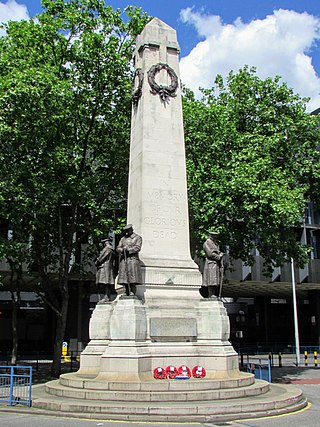
The London and North Western Railway War Memorial is a First World War memorial located outside Euston station in London, England. The memorial was designed by Reginald Wynn Owen, architect to the London and North Western Railway (LNWR), and commemorates employees of the LNWR who were killed in the First World War. Some 37,000 LNWR employees left to fight in the war—around a third of the company's workforce—of whom over 3,000 were killed. As well as personnel, much of the company's infrastructure was turned over to the war effort. Of the £12,500 cost of the memorial, £4,000 was contributed by the employees and the company paid the remainder.

Amar Jawan Jyoti is an Indian memorial conceptualised and constructed after the Indo-Pakistani War of 1971 and inaugurated on 26 January 1972. It was the national war memorial in India until February 2019, when the new National War Memorial and its own flame was inaugurated and lit. On 21 January 2022, the older flame was merged with the newer one at National War Memorial.

The Malta George Cross Memorial, also known as the Maltese Memorial, is a war memorial in London. It was erected to commemorate the Siege of Malta in the Second World War, which led to the island's being collectively awarded the George Cross in April 1942. Unveiled in 2005, it stands near the church of All Hallows-by-the-Tower.
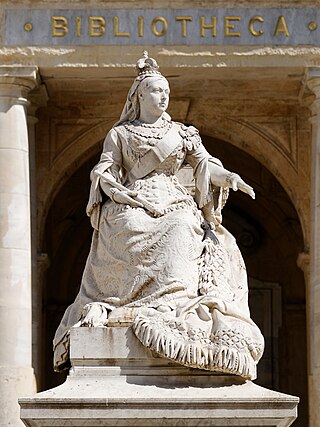
A statue of Queen Victoria stands in front of the National Library of Malta in Republic Square, Valletta, Malta. Sculpted out of marble by the Sicilian artist Giuseppe Valenti, the statue depicts the Queen sitting down and wearing a shawl of Maltese lace. It was installed in the square on 5 August 1891, replacing a bronze statue of António Manoel de Vilhena.

The statue of António Manoel de Vilhena is a life-sized Baroque bronze statue of António Manoel de Vilhena, a Portuguese Grand Master of the Order of St John. Commissioned in 1734 by the knight Felician de Savasse, it was sculpted by Pietro Paolo Troisi and cast by Aloisio Bouchut. In 1736 it was installed at Fort Manoel in Malta, and it was subsequently relocated a number of times. It was moved to Piazza Tesoreria in Valletta in 1858, to the entrance of The Mall gardens in Floriana in 1891, and to its present location at Pope John XXIII Square in Floriana in 1989.
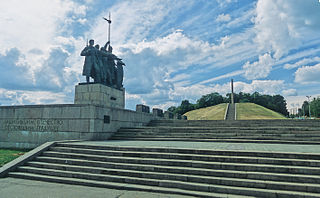
Boldyni Hory or Boldyni Hills historical area in the regional center of Chernihiv on the right bank of the Desna, as well as a monument of landscape art. Boldyni Hory are located two kilometers from the historic center of Chernihiv. From the center of Chernihiv one can walk or take public transport to Tolstoy street. The monuments are formed from 20 to 35-meter hills developed by an arc south of the floodplain of the Stryzhen River. The area has long been inhabited, many archeological, historical and architectural monuments have been preserved on its territory.

